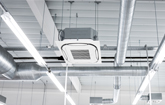CHICAGO, Aug. 23, 2021 /PRNewswire/ -- According to the new market research report "Air Quality Monitoring System Market by Product (Indoor, Outdoor, Wearable), Sampling (Stack, Manual, Passive), Pollutants (Chemical, Particulate Matter, Biological), User (Government, Petrochemical, Power plant, Residential) - Global Forecasts to 2026", published by MarketsandMarkets™, the global Air Quality Monitoring System Market is valued at USD 4.4 billion in 2021 and is expected to reach USD 5.9 billion by 2026, at a CAGR of 6.5% during the forecast period.
Browse in-depth TOC on "Air Quality Monitoring Systems Market"
222 – Tables
33 – Figures
286 – Pages
Download PDF Brochure: https://www.marketsandmarkets.com/pdfdownloadNew.asp?id=183784537
The growth of this market is majorly driven by factors such as rising levels of air pollution, supportive government regulations for effective air pollution monitoring and control, and ongoing initiatives toward the development of environment-friendly industries. Adding to this, increasing public-private funding for effective air pollution monitoring, and the increasing public awareness related to the environmental and healthcare implications of air pollution also supports the growth of this market.
The stack monitoring segment is expected to register the highest growth in the forecast period
The global air quality monitoring systems market is segmented on the basis of sampling method into active/continuous, intermittent, passive, manual, and stack monitoring.
The active/continuous monitoring segment commanded the largest share of the global air quality monitoring systems market in 2020, whereas the stack monitoring segment is projected to grow at the highest CAGR during the forecast period. Stack monitoring is the continuous measurement of air pollutants (such as gas or particulate matter) from industrial facilities. It is used to monitor air quality around waste incinerators, cement plants, and other industrial sources that need to comply with emission standards for hazardous air pollutants (HAPs) and volatile organic compounds (VOCs). Stack monitoring is undertaken annually, continuously, or for a 24-hour period, depending on the emission levels of industrial facilities as well as the regulations enforced on them. The low operational cost of stack monitoring, increasing government emphasis on regulatory compliance for industrial pollution monitoring, and the rising emphasis on pollution monitoring & control are factors expected to support the growth of this market
The fixed indoor monitors subsegment of indoor monitors holds the largest market share in 2020
Based on type of products, the global air quality monitoring systems market is segmented into indoor monitors, outdoor monitors, and wearables.
The indoor air quality monitors market is further segmented into fixed monitors and portable monitors.
The fixed indoor monitors is expected to account for the largest share of the indoor monitors market in 2020, primarily due to the growing need to maintain controlled indoor environment and monitor the level of atmospheric gases and air pollutants inside facilities like manufacturing units, laboratories, and storage area, among others, particularly in industries like pharmaceutical industries, biotechnology and microbiology industries, food and beverages industries, cosmetic industries, etc. Furthermore, the development of commercial sites as smart buildings is a rising trend. These smart buildings can communicate and connect with technologically advanced devices for better monitoring of air quality. This is another major factor driving the growth of the fixed indoor monitors market.
The chemical pollutant segment, by pollutant, is expected to register the market share of the global air quality monitoring systems market in 2020
Based on pollutants, the global air quality monitoring systems market is segmented into chemical pollutants, physical pollutants, and biological pollutants. The chemical pollutants segment accounted for the largest share of the global air quality monitoring systems market in 2020. This segment is projected to reach USD 4.43 billion in 2026. Market growth is mainly attributed to the rising levels of chemical air pollutants globally. In addition, the implementation of and the need to comply with stringent pollution monitoring and control regulations, growing public awareness, and the development and commercialization of innovative sensors are supporting the growth of this market segment.
Government agencies and academic institutes were the key end-users in the air quality monitoring systems market
Based on end user, the air quality monitoring systems market is segmented into government agencies and academic institutes, commercial and residential users, petrochemical industry, power generation plants, pharmaceutical industry, smart city authorities, and other end users.
Government agencies and academic institutes commanded the largest share of the global air quality monitoring systems market in 2020. The demand of air quality monitoring devices among government agencies and academic institutions is driven by active government initiatives for effective air quality monitoring, increased number of research collaborations, and increased installation of AQM stations worldwide.
Request Sample Pages: https://www.marketsandmarkets.com/requestsampleNew.asp?id=183784537
Asia Pacific is expected to see the highest growth in the air quality monitoring systems market by region
The global air quality monitoring systems market is segmented into five major regions, namely, North America, Europe, the Asia Pacific, Latin America, and the Middle East & Africa. North America is the largest regional market for air quality monitoring products, whereas the Asia Pacific market is estimated to grow at the highest CAGR during the forecast period.
Countries in this market are witnessing growth in their GDPs and a significant rise in disposable income among the middle-class population. These developments have led to increased government spending by various regional governments, modernization of industrial and public infrastructures, and rising penetration of cutting-edge environmental monitoring technologies (especially in rural areas).
The APAC is among the major contributors to air pollution on a global scale and also has a large patient population due to growing pollution levels. The APAC region has manufacturing hubs for various industrial products such as chemical products, petrochemical processing, and metals & mining, among others. Thus, this region is experiencing increasing demand for air quality sensors and monitors that are mainly driven by large-scale industrialization, implementation of stringent air pollution regulations across major Asian countries, and continuous government support for the development and commercialization of advanced products.
As of 2020, the air quality monitoring systems market was dominated by Thermo Fisher Scientific (US), 3M (US), Siemens (Germany), Teledyne Technologies (US), General Electric (US), Emerson Electric Company (US), Honeywell International Inc (US), HORIBA, Ltd. (Japan), Merck KGaA (Germany), and TSI Incorporated (US), among others.
Speak to Analyst: https://www.marketsandmarkets.com/speaktoanalystNew.asp?id=183784537
Browse Adjacent Markets: Analytical and Scientific Instrumentation Market Research Reports & Consulting
Browse Related Reports:
Environmental Monitoring Market by Product (Indoor, Outdoor Monitors [Fixed, Portable], Sensors, Wearables), Component (Particulate, Gas, Temperature, Noise), Sampling Method (Continuous, Active), Application (Air, Water, Soil, Noise) - Global Forecast to 2025
https://www.marketsandmarkets.com/Market-Reports/environmental-monitoring-market-216846315.html
Particle Counter Market by Type (Airborne, Liquid), Application (Cleanroom Monitoring, Contamination Monitoring of Liquids, IAQM), End User (Life Sciences & Medical Devices, Semiconductor, Automotive), Region - Global Forecast to 2025
https://www.marketsandmarkets.com/Market-Reports/particle-counter-market-221564539.html
About MarketsandMarkets™
MarketsandMarkets™ provides quantified B2B research on 30,000 high growth niche opportunities/threats which will impact 70% to 80% of worldwide companies' revenues. Currently servicing 7500 customers worldwide including 80% of global Fortune 1000 companies as clients. Almost 75,000 top officers across eight industries worldwide approach MarketsandMarkets™ for their painpoints around revenues decisions.
Our 850 fulltime analyst and SMEs at MarketsandMarkets™ are tracking global high growth markets following the "Growth Engagement Model – GEM". The GEM aims at proactive collaboration with the clients to identify new opportunities, identify most important customers, write "Attack, avoid and defend" strategies, identify sources of incremental revenues for both the company and its competitors. MarketsandMarkets™ now coming up with 1,500 MicroQuadrants (Positioning top players across leaders, emerging companies, innovators, strategic players) annually in high growth emerging segments. MarketsandMarkets™ is determined to benefit more than 10,000 companies this year for their revenue planning and help them take their innovations/disruptions early to the market by providing them research ahead of the curve.
MarketsandMarkets's flagship competitive intelligence and market research platform, "Knowledge Store" connects over 200,000 markets and entire value chains for deeper understanding of the unmet insights along with market sizing and forecasts of niche markets.
Contact:
Mr. Aashish Mehra
MarketsandMarkets™ INC.
630 Dundee Road
Suite 430
Northbrook, IL 60062
USA: +1-888-600-6441
Email: [email protected]
Research Insight: https://www.marketsandmarkets.com/ResearchInsight/air-quality-monitoring-equipment-market.asp
Visit Our Web Site: https://www.marketsandmarkets.com
Content Source: https://www.marketsandmarkets.com/PressReleases/air-quality-monitoring-equipment.asp
SOURCE MarketsandMarkets

WANT YOUR COMPANY'S NEWS FEATURED ON PRNEWSWIRE.COM?
Newsrooms &
Influencers
Digital Media
Outlets
Journalists
Opted In





Share this article